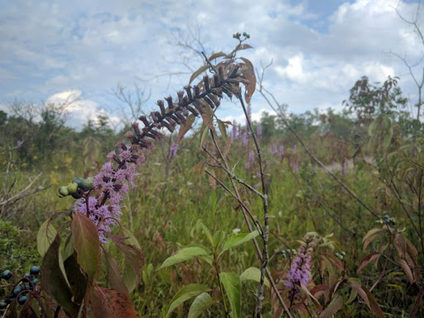
Photo by Daniel Nardone. Dense blazing star at Thundering Waters facing east towards now illegally cut Riverfront Residential site.
On January 25, 2020, the Niagara Peninsula Conservation Authority (NPCA), levelled charges against GR Canada, a developer associated with the Riverfront Residential development in Niagara Falls. These were the second charges levelled against GR Canada for illegally cutting trees on this site within past two years.
The Riverfront Residential development involves 80 acres of diverse natural habitats in a larger 500-acre ecosystem which has come to be known as the Thundering Waters forest. While most of this area is protected wetlands, they are surrounded by lands vulnerable to development that provide a refuge for an astonishing variety of rare species. These include the provincially rare Great Plains ladies’ tresses orchid and endangered bats. The forest, unusual for the Carolinian zone, is an intact block of around 300 acres, providing habitat for the endangered Acadian flycatcher.
Also ecologically significant is a 200-acre block tall hawthorn savanna. Development here threatens the breeding habitat of bird species dangerously declining throughout the continent. These are brown thrasher, field sparrow and black-billed cuckoo.
The recent charges are provincial offences under the Conservation Authorities Act for unauthorized site alteration within the boundaries of provincially significant wetlands and their buffers. These charges resulted in criticism by the Mayor of Niagara Falls Jim Diodatti, not for the cutting, but of the NPCA for levelling the charges. With the Mayor being outraged at the NPCA enforcing its laws, there is little hope that the City of Niagara Falls will enforce its site alteration by-law achieved through the work of a veteran environmentalist the late Peter Grandoni, that prohibits changes to the landscape of proposed developments prior to subdivision registration.
The earlier charges against GR Canada were filed fall of 2018 concerning a violation of the Niagara Region’s tree by-law. These charges were for illegal tree removal done to facilitate a path for a machine to do bore-hole drillings for environmental testing. No trees have subsequently been planted to repair the damage. Native species from the surrounding forest such as grey dogwood have simply been permitted to grow back. Some of the ground, however, is still scarred by potholes. These impacts have been attributed to off-road vehicles although no tracks can be seen.
A few days following the second cut, on January 30, 2020, a public information session was held at the Gale Center (Niagara Falls Arena), on the Riverfront Residential development proposal. Around 250 residents expressed outrage over the development proposal and illegal cutting. After more than a year no representative of Savanta, the developer’s ecological consultant, has been on-site to do any tree planting or monitor recovery. Savanta indicated that they have never been present on the two damaged sites which resulted in the charges of illegal activity.
The latest cut took place over three days and involved lands which should, under provincial criteria, be designated as Significant Wildlife Habitat. This being crucial breeding habitat for declining bird species that rely on thorny bushy habitats such as hawthorn savannahs.
The absence of employees of Savanta who could have controlled the bushwhacking was especially tragic in view of the consequences for the Great Plains ladies’ tresses. All of the habitat of this provincially rare orchid which was carefully mapped by Savanta was mowed down in their absence.
Under Savanta’s ecological restoration plan, the rare orchid was supposed to be gathered up to what the Ecological Impact Study termed “transplant locations known as Native Restoration Areas.” A sample experiment transplant was to be done “prior to undertaking the larger scale transplant of the main population”. These hopes were literally mowed down.
Also mowed down without care, was a beautiful, orange-coloured regionally rare wildflower, the butterfly milkweed, slated to be transplanted to a restoration meadow. Butterfly milkweed provides habitat for another significant species, the monarch butterfly.
The mass mowing of fifty acres of shrub/early successional breeding bird habitat also impacted “some foraging habitat” used by the two species of endangered bats. These are the little brown myotis and the northern myotis. These bat species experienced a devastating population cull due to the white-nose fungus and are slowly starting to recover. Since they roost in the old-growth trees of the protected wetlands, bats use the insect-rich hawthorn savanna for summer foraging. For the same reason, this habitat is beneficial for the threatened barn swallow.
One area that was blessedly saved from the bushwhacker is just outside the boundaries of the proposed Riverfront Residential development. It is supposed to be designated as Development Holding and was so spared for now. This is the site of a threatened wildflower, dense blazing star, discovered in the summer of 2017 during an occupation of the site by Daniel Nardone. These 20 acres were withdrawn from the proposed development and therefore rescued from the bushwhacker’s blades
What makes the devastation of the big cut so outrageous are the LPAT words of approval of Niagara Falls Official Plan Amendment (OPA) 128 which authorized the current Riverfront Residential zoning process now underway. Penned by LPAT hearing officer Sharon Vincent they denied that any such outrage would take place. Ms Vincent stated, “Mr Bacher‘s interpretation appears to be based on a lack of comprehension of the rigours of the planning process which will still be ahead before any aspect of the site is altered.” To the contrary, the “lack of comprehension” of the planning process has been shown by LPAT in approving Amendment 128, as shown by the mowing down of the habitat of rare species in contradiction to the plans of the developer’s own ecological consultants.
